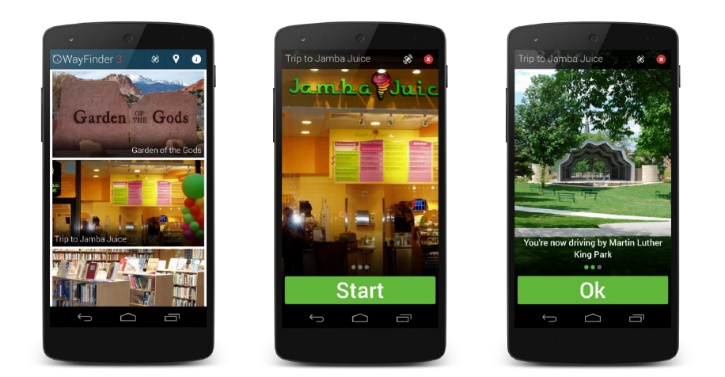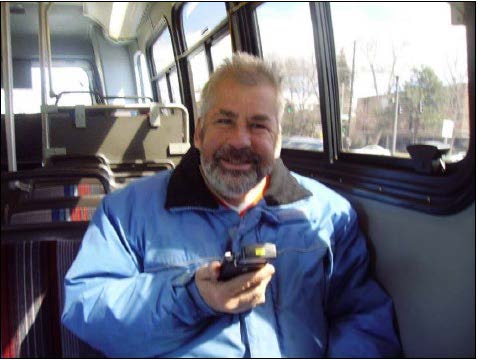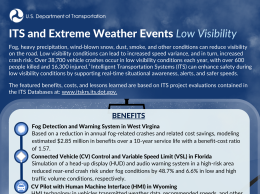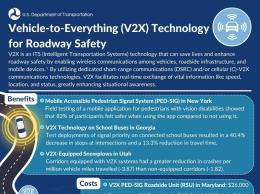Using Technology to Support Travelers with Disabilities
This case study discusses "Using Technology to Support Travelers with Disabilities." The project discussed in this case study was part of the Accessible Transportation Technologies Research Initiative (ATTRI) Program.
IN THIS CASE STUDY YOU WILL LEARN:
- Why the ATTRI Program helped to fund technologies to support independent travel.
- How research and field tests have shaped technology development and expansion.
- How ATTRI has spurred additional innovation to support accessibility.
The ATTRI Program: An Introduction
| In 2018, the National Aging and Disability Transportation Center reported that 25.5 million Americans aged 5 and older have self-reported disabilities that limit travel.1 |
People with disabilities are more likely to lack equitable access to transportation systems.1 To help address this issue, the Accessible Transportation Technologies Research Initiative (ATTRI) Program—a joint US Department of Transportation effort between the Federal Highway Administration, Federal Transit Administration, and Intelligent Transportation Systems Joint Program Office—was designed to improve access to transportation systems for people living with visual, hearing, cognitive, and mobility disabilities by developing and implementing a suite of new technologies.2
ATTRI funded four technology development areas: wayfinding and navigation, pre-trip concierge and virtualization, safe intersection crossing, and robotics and automation.2 This case study details the development of a travel assistance app to enable better pre-trip planning and wayfinding for people with cognitive disabilities.
| Problem | Navigating a transportation system that is not built for people living with cognitive disabilities can be difficult. While on public transportation, travelers can experience confusion, anxiety, visual impairments, and memory challenges, among other issues.3 Additionally, some in this community are ineligible for on-demand paratransit services, making them dependent on traditional public transit services.4 |
| Goal | Support independent travel for the target user group via technologies that provide step-by-step visual and audio direction.5 |
| Solution | The ATTRI Program funded several projects to respond to this need by assessing pre-trip planning ability, teaching through self-directed learning, and supporting trip execution. The technologies developed from ATTRI can be implemented by networks or transit systems to support riders along their journey. For example, one app utilizes GPS data to show pictures, landmarks, and locations along a user’s route and prompts the user when needed, such as when they have reached their destination. |
Background

People living with cognitive disabilities often must rely on caregivers, paratransit, or private transportation providers to meet their transportation needs. For travelers with cognitive disabilities, having to rely on others to meet their travel needs can constrain their travel options, limit their ability to fully explore their communities, and inhibit full independence. These constraints often have negative secondary effects such as limiting employment opportunities.1 Additionally, providing specialized transportation services can be resource intensive for many providers or caregivers.6
Shifting people with cognitive disabilities onto fixed route transit through travel training and travel assistance services has long been viewed as an important way to increase independence for people with cognitive disabilities and reduce service providers’ need to provide specialized transportation services for this population.
Travel training is an immersive learning experience which helps people with cognitive disabilities learn how to meet their own mobility needs, typically by using fixed route transit. Travel trainers work with individuals to teach them a variety of skills, depending on the individual’s needs, such as which bus to take, where to get off, and how to navigate pedestrian environments. Once travelers have completed training, many are able to use fixed route transit to meet some or all of their mobility needs.3
Although travel training is a valuable method for improving travel independence, it has several limitations. Notably, travel training can be time consuming, not particularly flexible, and cannot help travelers en route should issues arise.
Initial App Testing Informs Improvements
To address some of these issues, in 2017 the ATTRI Program awarded a grant to an app development company that focused on creating a travel assistance software ecosystem for people with cognitive disabilities. This app uses a combination of computer-based and smartphone technologies to provide travel training to individuals with cognitive disabilities with minimal caregiver intervention. It also provides travelers with en route assistance after they have completed travel training, further enhancing their ability to use public transit.3,7,8
Since the app developer had previously prototyped and tested their travel assistance app on a small scale with promising results, their ATTRI effort focused on identifying new opportunities for improving the app and developing and expanding app features.
To help with this, a steering committee consisting of people with disabilities, caregivers, parents, technology developers, disability professionals, transit professionals, and many more met twice a month to provide their input into the development process and evaluate the app features. By engaging stakeholders early and continuously throughout the process, people with intimate knowledge of the needs of travelers with cognitive disabilities helped identify key features to be added. Based on this feedback (and previous work) the developer focused on developing a custom route builder software, expanding pre-trip virtualization tools, and incorporating transit route information.7,8
Field Testing and Results
| During field testing in Albuquerque, participants completed 596 trips and traveled almost 6,500 miles on the bus.7 |
After making these improvements, community partners and service providers in Pittsburgh, Pennsylvania; Rapid City, South Dakota; and Albuquerque, New Mexico agreed to train people living with cognitive disabilities to use the app and then conduct large-scale field testing. These sites were selected based on their expertise in working with people with cognitive disabilities and their desire to increase travel independence for people in their community.
Each user worked with a travel trainer to assess their unique travel needs. Then, the trainers, in combination with the travel assistance app, trained users on how to take public transit and use the app. Finally, the individuals with cognitive disabilities were assisted in using the app to navigate the public transit system in their city to get to various destinations such as work, shopping centers, and restaurants.
A Game ChangerThe Black Hills Works organization in Rapid City, South Dakota shared the following feedback from their implementation of the AbleLink Wayfinder app, which is cited in a 2019 USDOT report.7 “I can definitely say the WayFinder has been a game changer for the individuals that we have trained to use it. They have been able to keep and obtain jobs in our community, shop, get to medical appointments, and visit their friends and family when they want and not have to wait for staff to give them rides.” - Tammy Murner, Black Hills Works Director of Innovation and Assistive Technology After using Wayfinder just two times with a staff guide, one participant became so confident, he declared, “Ok, I don’t need you anymore!” and began to travel to work on his own using WayFinder. |
After completing training sessions, many of the participants were able to independently navigate the transit system, which greatly improved their quality of life. For example, one participant in Pittsburgh went from being reliant on paratransit services to being able to independently explore their community. Because of this they were able to obtain seasonal employment at a local mall. Another individual was able to independently explore their local mall and enjoyed the many opportunities this presented them.
Similarly, the caregiver experience was improved as an outcome of this research. Caregivers, who previously might have accompanied travelers en route or driven them to their destination, could begin the process of building independence for travelers. In addition to building and saving routes, a tracking functionality was added to allow caregivers and families to track their loved one’s whereabouts in real time, providing “peace of mind.” Overall, the web-based route builder, route repository database, and trip tracker provide additional functionality to ensure the safety of users and a suite of tools for caregivers.7
Due to the success of this project, the travel assistance app has been used in other pilot projects across the country, and USDOT is continuing to support the development of technologies for people with cognitive disabilities. In January 2021, USDOT, through its competitive Inclusive Design Challenge, awarded funds to develop innovative design solutions that will enable people with physical, sensory, and cognitive disabilities to use automated vehicles to access critical destinations.8,9
Lessons Learned
Technology Can Reduce Barriers to Public Transit Use
Travelers with cognitive disabilities often rely on paratransit or private shuttle services to meet their travel needs because barriers to public transit are too high. However, with the aid of the travel assistance app travelers were able to utilize public transit to a much greater degree. The travel assistance app also overcame many of the challenges associated with traditional travel training, most notably by providing users more real-time, en route assistance than before. This assistance is especially valuable when deviations from normal occur. For example, the app can inform users of late buses.

This demonstrates how technological solutions can alleviate barriers to public transit use, which suggests that this model could be replicated for other traveler groups in the future, such as for people who are blind or low vision. Overall, these technologies can expand independence for different traveler groups while freeing up service provider resources.
Early and Frequent Input from Stakeholders is Valuable
As mentioned, throughout this ATTRI effort, a steering committee met twice a month to provide their input into the development process. This inclusive, iterative, and human-centered development process was very successful. By allowing stakeholders direct input into the development of the app at each stage of the process, the end product was more useful to the end users.7 Future efforts should seek to replicate this by engaging stakeholder communities on an on-going basis and allowing them to provide real input into the planning and development process.8
Community Partners Can Greatly Increase Acceptance of New Technology
Working with community partners to disseminate information about new technologies proved invaluable for the ATTRI project. Community partners who understood the unique needs of users with cognitive disabilities were able to support users in learning the new technology, which greatly accelerated user acceptance. These community partners had established credibility and trust with users and were able to demonstrate the technology and train users in a comfortable environment.7,8
Evaluate the Impact of Technologies Within Context
Too often evaluation of transportation investments or new technologies takes place in a limited set of circumstances. As the ATTRI Evaluation Framework discusses, this can cause evaluations to be misleading, as technologies or investments may create new challenges for travelers or have significant spillover effects. As this project demonstrates, evaluating an investment or technology within real-world contexts can give a broader sense of how technologies or investments function, which in turn allows for a more realistic understanding of the impacts of a new technology or investment.10 In this particular case, holistic evaluation allowed for the identification of technology gaps that still impacted users, that more rigid evaluations might have missed. For example, independent evaluation of the Wayfinder system identified a number of technology gaps, such as the app not providing interpretation of external announcements on transit, which should be addressed in future versions of the app.11
References
- National Aging and Disability Transportation Center. “Travel Patterns of American Adults with Disabilities.” Accessed May 26, 2021. https://www.nadtc.org/news/blog/travel-patterns-of-american-adults-with-disabilities/
- “Intelligent Transportation Systems - Accessible Transportation Technologies Research Initiative.” Accessed May 5, 2021. https://www.its.dot.gov/research_archives/attri/index.htm
- "Publications and Presentations | Smart Columbus Wayfinder Study.” Accessed May 12, 2021.https://u.osu.edu/smartcbus/publications-and-presentations/
- Ellis, Buffy. “Research Brief TCRP Report 163: Strategy Guide to Enable and Promote the Use of Fixed-Route Transit by People with Disabilities.” Transportation Research Board, 2014.http://onlinepubs.trb.org/onlinepubs/tcrp/tcrp_rpt_163IBADA.pdf
- “ATTRI Project Update Webinar 1 - AbleLink Pre-Trip Concierge & Virtualization.” November 7, 2017.https://www.its.dot.gov/presentations/2017/ATTRI_Webinar_nov2017s.pdf
- Maisel, Jordana, Molly Ranahan, and Jimin Choi. “Factors Influencing Fixed-Route Transit Decision-Making: Exploring Differences by Disability and Community Type.” Journal of Public Transportation 23, no. 1 (March 9, 2021). https://doi.org/10.5038/2375-0901.23.1.1
- Stock, Steven E., and Daniel K. Davies. “STCS Pre-Trip Planning and Virtualization: Project Report.” Oklahoma City, OK: Federal Highway Administration, November 31, 2019. https://rosap.ntl.bts.gov/view/dot/44053
- Davies, Dan, and Steve Stock. ITS Evaluation Case Study Interview Wayfinder Development. Interview by Olivia Posner and Haley Townsend. Conference Call, April 8, 2021
- “Inclusive Design Challenge Semifinalists | US Department of Transportation.” Accessed May 17, 2021.https://www.transportation.gov/inclusive-design-challenge/inclusive-design-challenge-semifinalists
- Caspi, Anat, Mark Hallenbeck, and Shannon Tyman. “Accessible Transportation Technologies Research Initiative(ATTRI) Performance Metrics and Evaluation.” Final. Washington, D.C.: U.S. Department of Transportation ITS Joint Programs Office, July 2020. https://rosap.ntl.bts.gov/view/dot/50748/dot_50748_DS1.pdf
- Caspi, Anat, Mark Hallenbeck, Varsha Konda, and Dylan Cottrell. “Accessible Transportation Technologies Research Initiative (ATTRI) Performance Metrics and Evaluation: Evaluation Results for the AbleLink Wayfinding Standard to Facilitate Independent Use of Public Transit by Individuals with Cognitive Disabilities.” Final. Washington, D.C.: U.S. Department of Transportation ITS Joint Programs Office, May 2021.


